

Samos. Samos (/ˈseɪmɒs, ˈsæmoʊs/; Greek: Σάμος) is a Greek island in the eastern Aegean Sea, south of Chios, north of Patmos and the Dodecanese, and off the coast of Asia Minor, from which it is separated by the 1.6-kilometre (1.0 mi)-wide Mycale Strait.
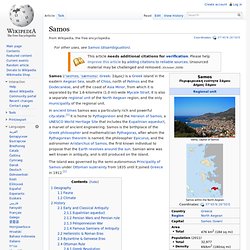
It is also a separate regional unit of the North Aegean region, and the only municipality of the regional unit. In ancient times Samos was a particularly rich and powerful city-state. It is home to Pythagoreion and the Heraion of Samos, a UNESCO World Heritage Site that includes the Eupalinian aqueduct, a marvel of ancient engineering. Greeks. The Greeks (Greek: Έλληνες [ˈe̞line̞s]) are an ethnic group native to Greece, Cyprus, Anatolia and other regions.
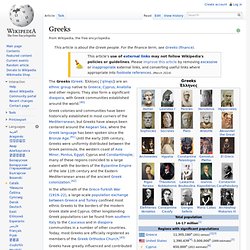
They also form a significant diaspora, with Greek communities established around the world.[40] Greek colonies and communities have been historically established in most corners of the Mediterranean, but Greeks have always been centered around the Aegean Sea, where the Greek language has been spoken since the Bronze Age.[41] Until the early 20th century, Greeks were uniformly distributed between the Greek peninsula, the western coast of Asia Minor, Pontus, Egypt, Cyprus and Constantinople; many of these regions coincided to a large extent with the borders of the Byzantine Empire of the late 11th century and the Eastern Mediterranean areas of the ancient Greek colonization.[42] History[edit] A reconstruction of the 3rd millennium BC "Proto-Greek area", according to Bulgarian linguist Vladimir Georgiev. Origins[edit] Sounion. Cape Sounion Sunset at Cape Sounion.

Cape Sounion (Modern Greek: Aκρωτήριο Σούνιο, transliterated Akrotírio Soúnio, pronounced [akroˈtirʝo ˈsuɲo]; Ancient Greek: Ἄκρον Σούνιον, Άkron Soúnion; Latin: Sunium promontorium; Venetian: Capo Colonne - "Cape of Columns") is a promontory located 69 kilometres (43 mi) SSE of Athens, at the southernmost tip of the Attica peninsula in Greece. Delos. The island of Delos (/ˈdiːlɒs/; Greek: Δήλος, [ˈðilos]; Attic Δῆλος, Doric Δᾶλος), near Mykonos, near the centre of the Cyclades archipelago, is one of the most important mythological, historical and archaeological sites in Greece.
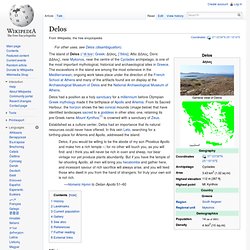
The excavations in the island are among the most extensive in the Mediterranean; ongoing work takes place under the direction of the French School at Athens and many of the artifacts found are on display at the Archaeological Museum of Delos and the National Archaeological Museum of Athens. Established as a culture center, Delos had an importance that its natural resources could never have offered. In this vein Leto, searching for a birthing-place for Artemis and Apollo, addressed the island: Delos, if you would be willing to be the abode of my son Phoebus Apollo and make him a rich temple –; for no other will touch you, as you will find: and I think you will never be rich in oxen and sheep, nor bear vintage nor yet produce plants abundantly. History[edit] Knossos. Knossos, Knossus, or Cnossus (/ˈnɒsəs/; Greek: Κνωσός or Κνωσσός, pronounced [knoˈsos]) is the largest Bronze Age archaeological site on Crete and is considered Europe's oldest city.[4]
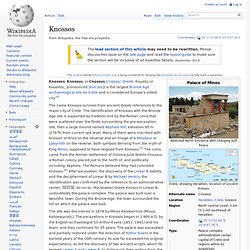
Mount Athos. Mount Athos (/ˈæθɒs/; Greek: Όρος Άθως, Óros Áthos [ˈoros ˈaθos]) is a mountain and peninsula in Greece.
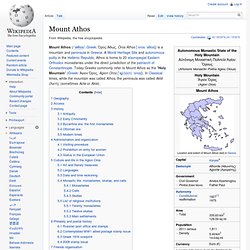
A World Heritage Site and autonomous polity in the Hellenic Republic, Athos is home to 20 stavropegial Eastern Orthodox monasteries under the direct jurisdiction of the patriarch of Constantinople. Today Greeks commonly refer to Mount Athos as the "Holy Mountain" (Greek: Άγιον Όρος, Agion Oros [ˈaʝ(i)o(n) ˈoros]). Stagira-Akanthos. Subdivisions[edit] The municipal unit Stagira-Akanthos is subdivided into the following communities: See also[edit] Strymonian Gulf.
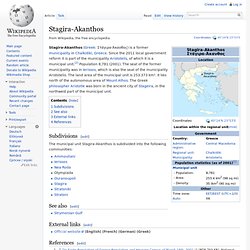
Delphi. Apollo's sacred precinct in Delphi was a panhellenic sanctuary, where every four years, starting in 586 BC [5] athletes from all over the Greek world competed in the Pythian Games, one of the four panhellenic (or stephanitic) games, precursors of the Modern Olympics. The victors at Delphi were presented with a laurel crown (stephanos) which was ceremonially cut from a tree by a boy who re-enacted the slaying of the Python.[5] Delphi was set apart from the other games sites because it hosted the mousikos agon, musical competitions.[3] These Pythian Games rank second among the four stephanitic games chronologically and based on importance.[5] These games, though, were different from the games at Olympia in that they were not of such vast importance to the city of Delphi as the games at Olympia were to the area surrounding Olympia.
In the inner hestia ("hearth") of the Temple of Apollo, an eternal flame burned. Delphi among the main Greek sanctuaries. Location[edit] Oia, Greece. Oia (Greek: Οία, pronounced [ˈi.a]) is a small town and former community in the South Aegean on the islands of Thira (Santorini) and Therasia, in the Cyclades, Greece.

Since the 2011 local government reform it has been part of the municipality of Santorini, of which it is a municipal unit.[2][3] It covers the whole island of Therasia and the northwesternmost part of Santorini, which it shares with the municipal unit of Santorini. The main street is named Nikolaou Nomikou. The population was 3376 inhabitants at the 2001 census, and the land area is 19.449 km2[2][4] Mykonos. Mykonos (/ˈmɪkəˌnɒs/, /ˈmɪkəˌnoʊs/;[1] Greek: Μύκονος [ˈmikonos]) is a Greek island, part of the Cyclades, lying between Tinos, Syros, Paros and Naxos.
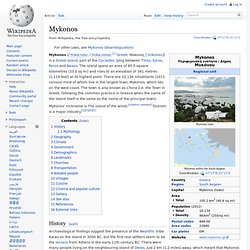
The island spans an area of 85.5 square kilometres (33.0 sq mi) and rises to an elevation of 341 metres (1,119 feet) at its highest point. There are 10,134 inhabitants (2011 census) most of whom live in the largest town, Mykonos, which lies on the west coast. The town is also known as Chora (i.e. the Town in Greek, following the common practice in Greece when the name of the island itself is the same as the name of the principal town). Meteora. The Katholikon of Holy Trinity Monastery, Meteora.

History[edit] The Theopetra caves 5 kilometres (3.1 mi) south of Meteora had inhabitants fifty millennia ago.[4] The oldest known example of a man-made structure was found within a prehistoric cave in central Greece, according to the Greek culture ministry. Mount Olympus. Olympus' highest peak, Mytikas Every year thousands of people visit Olympus to admire its nature, to tour its slopes, and reach its peaks. Organized mountain refuges and various mountaineering and climbing routes are available to visitors, who want to explore its nature. Corinth Canal. The Corinth Canal (Greek: Διώρυγα της Κορίνθου, Dhioryga tis Korinthou) is a canal that connects the Gulf of Corinth with the Saronic Gulf in the Aegean Sea.
It cuts through the narrow Isthmus of Corinth and separates the Peloponnese from the Greek mainland, thus effectively making the former peninsula an island. The builders dug the canal through the Isthmus at sea level; no locks are employed. It is 6.4 kilometres (4.0 mi) in length and only 21.4 metres (70 ft) wide at its base, making it impassable for most modern ships. It now has little economic importance. The canal was mooted in classical times and an abortive effort was made to build it in the 1st century AD. Acropolis of Athens. Coordinates: Olympia, Greece. Olympia (Greek: Ολυμπία Olympía), a sanctuary of ancient Greece in Elis, is known for having been the site of the Olympic Games in classical times, the most famous games in history. The Olympic Games were held every four years throughout Classical Antiquity, from the 8th century BC to the 4th century AD.[2] The first Olympic Games were in honor of Zeus.
Ancient site[edit] The sanctuary, known as the Altis, consists of an unordered arrangement of various buildings. Santorini Hotels: Santorini.com - official site - Santorini Hotels Santorini Greece.